Introducing – Atelier de Chronométrie AdC #5 – 1940s Style and Mechanics Brought Back in Hand-Made Timepieces
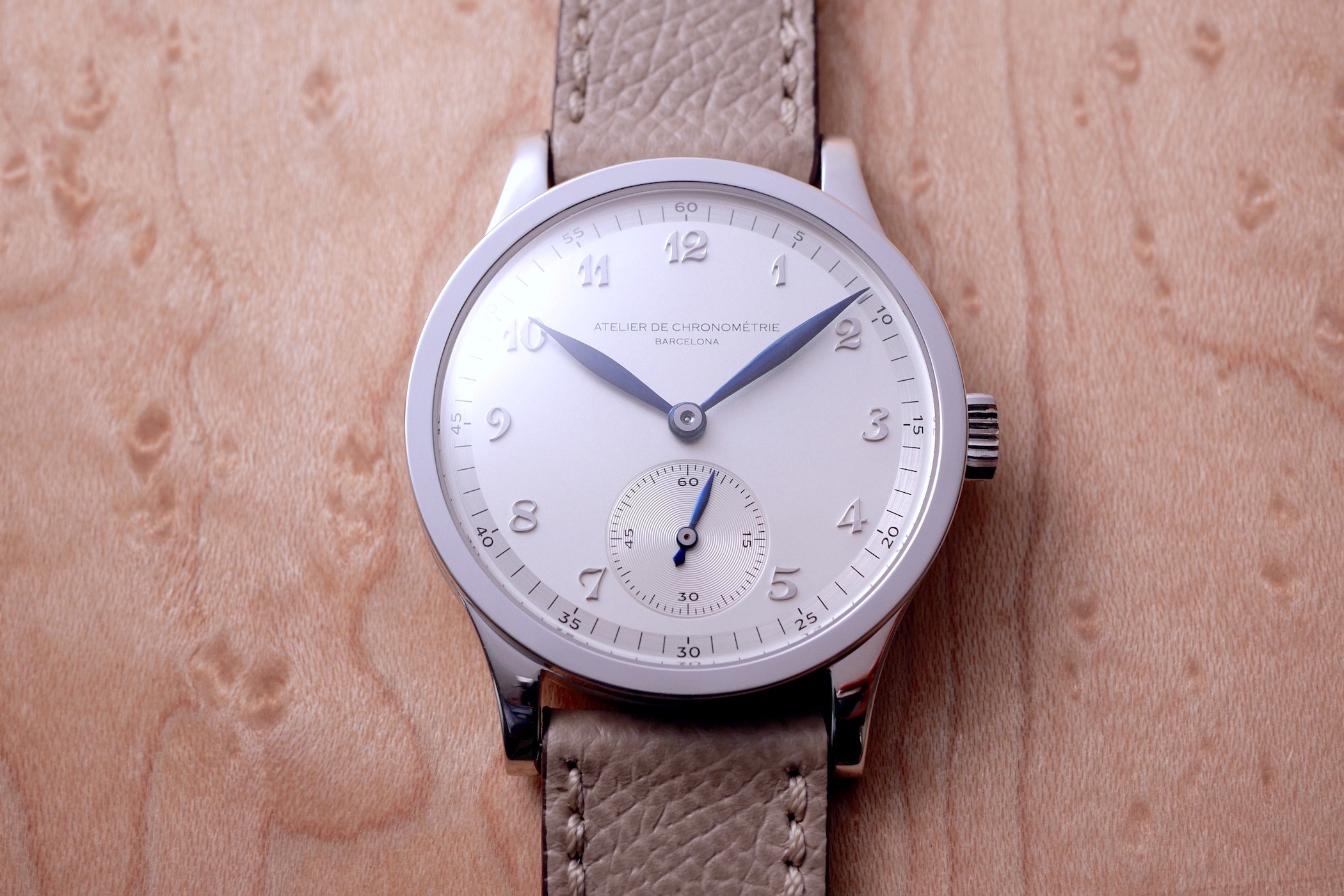
If there’s one thing I love about my job is to discover new watch brands. I’m always stunned by the level of creativity infused by independent watchmakers, from the Sci-Fi creations of Urwerk or the ultra-classic propositions of Laurent Ferrier (who can do nice things together…) One brand we recently discovered at MONOCHROME cumulates quite some intriguing specificities. It isn’t Swiss, but it makes things in an ultra-traditional way, whether for the design or the manufacturing process, and it’s all about one-off pieces. This brand is Atelier de Chronométrie and their latest creation is the AdC #5, which brings back to present times the superb 1940s design and mechanics.
Background
The philosophy of Atelier de Chronométrie is to create one-off watches with the pure aesthetics of the 1930s and 1940s, in a package that is not infused with modernism. Behind this brand, there’s no idea of vintage inspiration or reeditions of glorious models with modern mechanics or modern techniques. The sheer beauty of Atelier de Chronométrie sits in the fact that not only are the design and inspirations from the inter-war period but, for our biggest pleasure, everything from the way their watches are manufactured to the movements that power them is historically relevant.
The Atelier de Chronometrie AdC 1, the first creation of the brand
This Barcelona-based brand (indeed, far away from the Swiss mountains) creates unique watches by hand – and when they say by hand, it means without the use of modern machines, such as CNC. Moebius Rassmman, a watchmaker with more than 20 years of experience, and Santiago Martínez, a collector and vintage watch dealer expert in Patek Philippe, the two co-founders of Atelier de Chronométrie, only use traditional design cues, traditional manufacturing processes and use vintage Omega movements, entirely restored and remade, to power their watches. Relevant, from A to Z.
The Atelier de Chronometrie AdC 3, a more luxurious and Art-Deco take on the brand’s design
Considering this flexibility, they have been creating watches only made to measure at the buyer´s request. Customers can choose from unlimited options such as the case material, the type of dial design and a wide range of choices to customize the calibre. Each wristwatch is a one-off piece, designed exclusively for the customer and never repeated for any other. Thus, the watch that we’re about to show you is indeed creating a new collection for the brand, it could be considered as a base for future unique creations.
The new Atelier de Chronométrie AdC #5
Like all the creations of Atelier de Chronométrie, this new AdC #5 is fully inspired by 1940s watches, with a strong Patek Phillipe influence1. Compared to the previous watches they have manufactured, this AdC #5 is presented in a very clean style, emphasizing two specificities: the applied Breguet numerals and the blued steel hands – two features that are clearly dear to vintage collectors.
The present Atelier de Chronométrie AdC #5 – don’t forget that this is a one-off piece – is presented in a 37.5mm case, the standard size for the brand, yet as always, the diameter can be adjusted from 35mm to 38.5mm on request. The 18k white gold case is shaped in the most traditional Calatrava/coin-edge style, a design made famous by Patek Phillipe in the early 1930s, which combines a central part with integrated lugs and a flat, angular bezel on top. As a more luxurious and slightly dressier version, this AdC #5 is polished on the upper parts, yet it will be easy to ask for brushed surfaces all around.
The dial of the Atelier de Chronométrie AdC #5 follows the same idea, with a two-tone silvered plate on which are applied some raised Breguet numerals. Combining a circular-brushed minute track with a matte central area and a small second with azurage (concentric pattern), time is indicated by 3 completely handcrafted blued steel hands with a classical leaf shape. The contrast with the metallic dial and numerals is superb and the execution, as always with this manufacture, is impeccable.
The pièce de résistance of this watch sits under the sapphire caseback. To power the 3-hand display is a historically relevant movement, an Omega Calibre 266, a variant of the highly respected Omega 30T2 calibre. Yet, the team of Atelier de Chronométrie didn’t just oil and service the movement. What they’ve done is create a proper Haute-Horlogerie movement based on this Omega Calibre 266. All the plates and bridges are replaced by internally hand-crafted parts, done without the help of CNC machines. The movement is here presented with 18k yellow gold plating on the 4 bridges, blued screws and 18k pink gold plated and rhodium plated accents.
All in all, 21 pieces are replaced and completely remade, specifically to create the movement of the Atelier de Chronométrie AdC #5. Other parts are entirely reshaped and refined to fit the high-end concept. The finishing and decoration include hand-made frosting on the bridges and plates, double snailed finishing with a matte finished centre on the ratchet wheel and the ratchet click, hand-made anglage on the bridges, including inward angles, bevelled wheel spokes and polished countersinks. The shape of the bridges is also completely different from the original Omega vintage calibre, and its specifications have been improved too, with the addition of a free sprung balance regulated by inertial screws or a KIF anti-shock system.
The Atelier de Chronométrie AdC #5 is another extremely refined and subtle piece, which has clearly been made for the most mature collectors. Its beauty is discreet and maybe hard to get for more novice enthusiasts, especially knowing the approximate EUR 40,000 price (depending on the options chosen of course). Steep indeed but this feels justified by the amount of hand-work done here. More details on www.atelierdechronometrie.com.
Technical Specifications – Atelier de Chronométrie AdC #5
- Case: 37.5mm diameter (35mm to 38.5mm on request) – white gold case (other materials on request) – sapphire crystal on both sides
- Dial: two-tone silvered dial with applied Breguet numerals – hand-crafted blued steel hands
- Movement: Restored and re-built movement based on Omega calibre 266 – hand-wound – 3Hz frequency – 13 lines and 4mm height – 17 jewels – Power reserve 38 hours – entirely crafted and decorated by hand – hours, minutes, small seconds
- Strap: leather strap – 18k white gold buckle

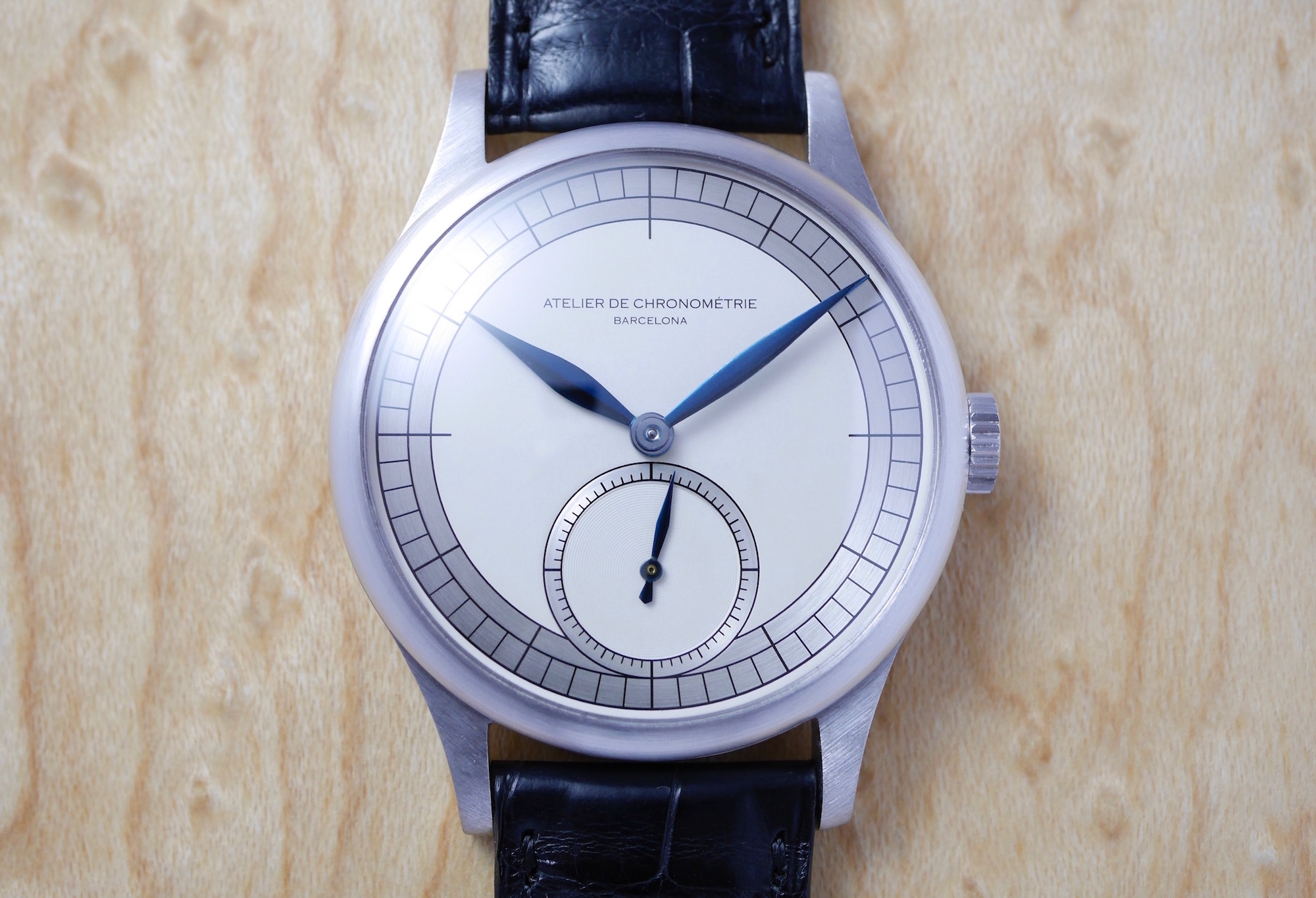
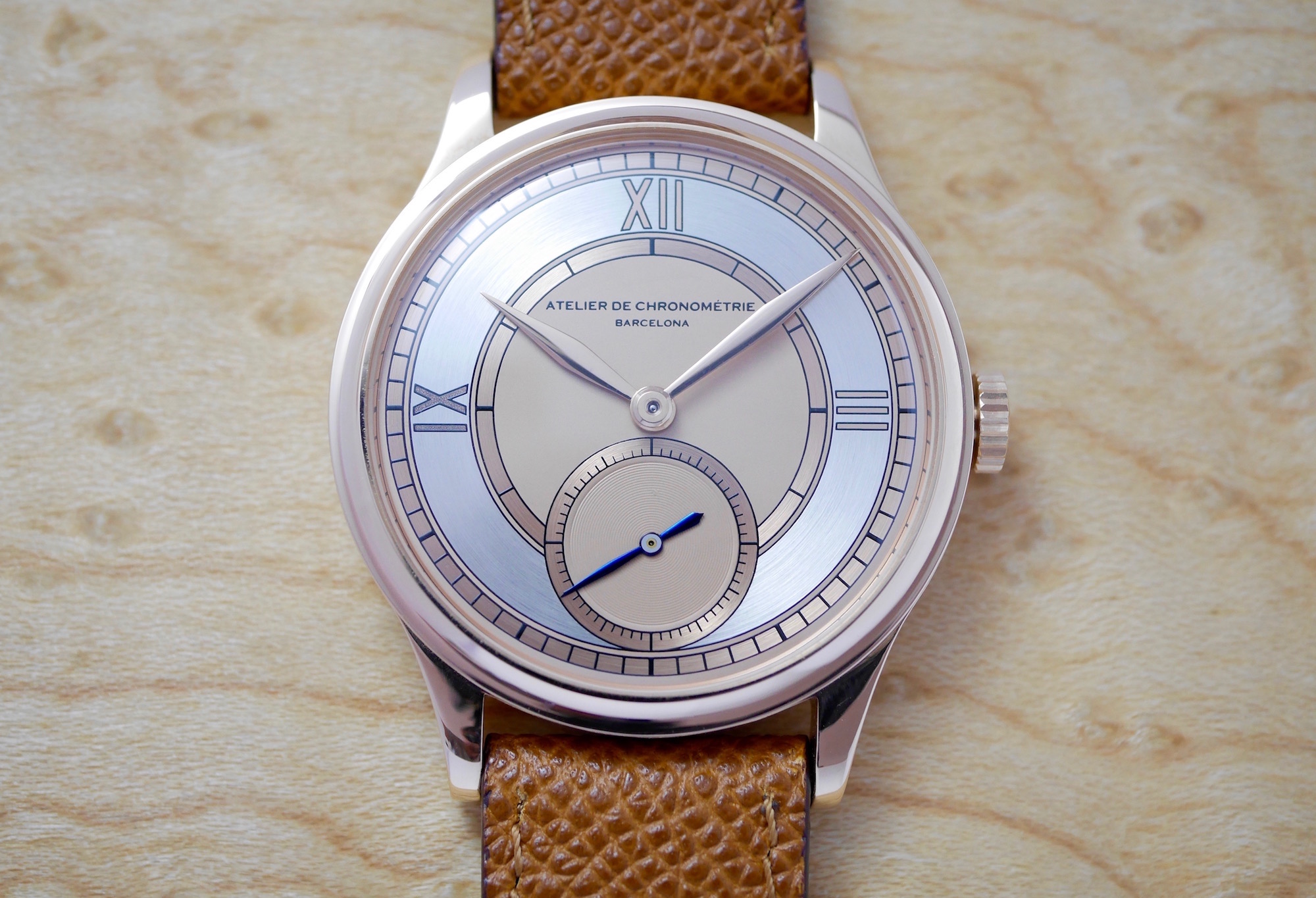



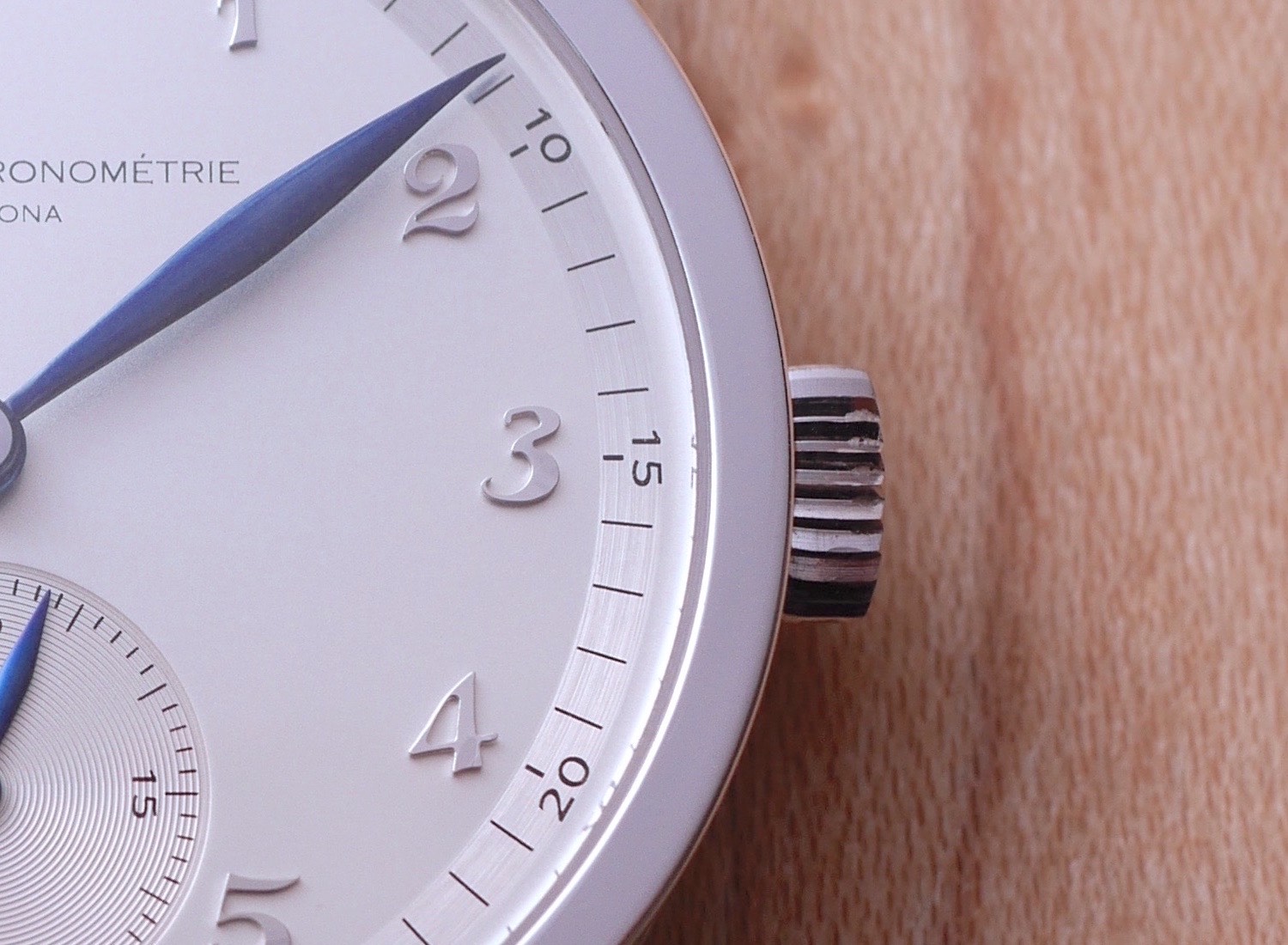
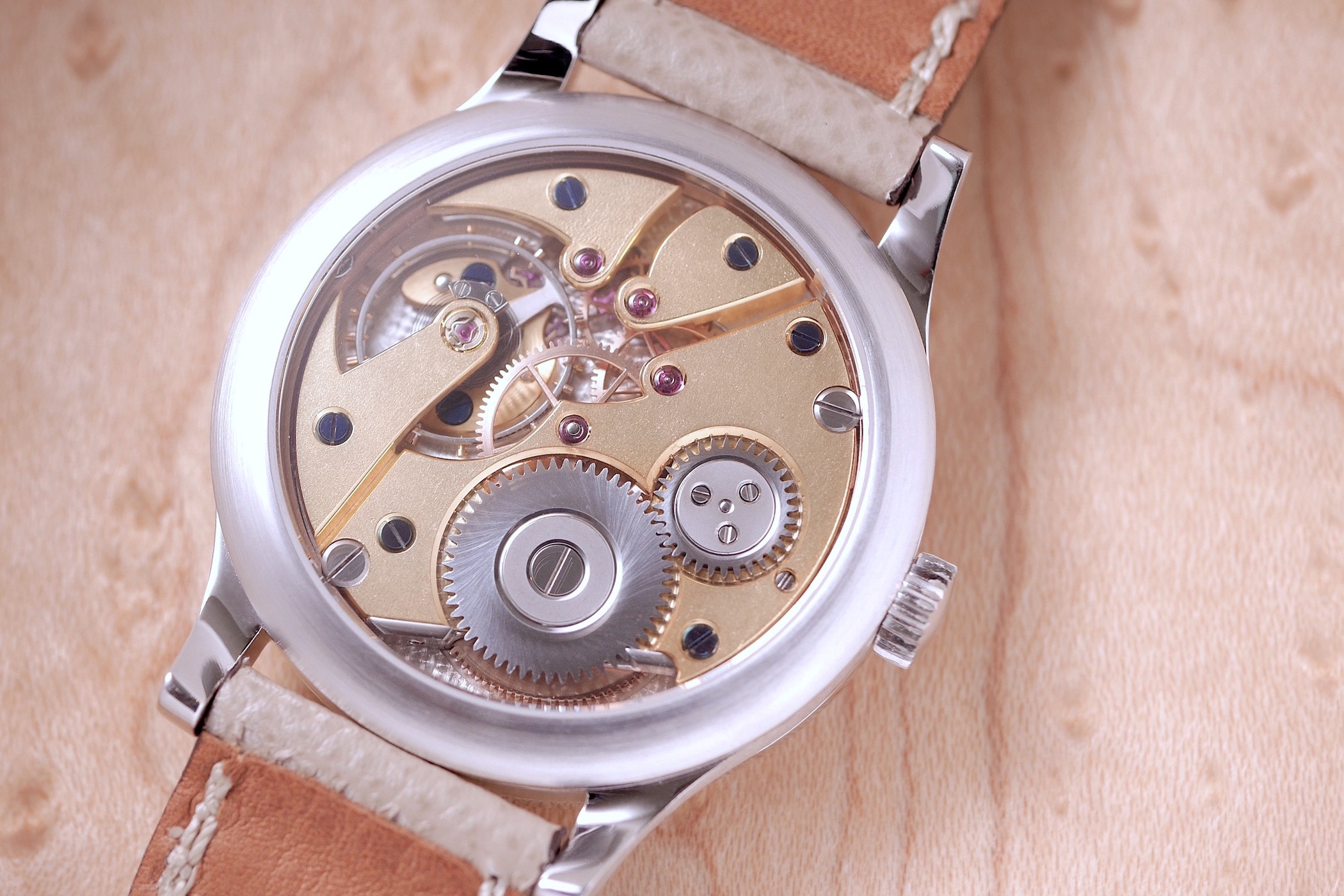




8 responses
When one thinks at this price point a Petek would be one of their mass made pieces with a huge amount of automated finishing and not to the standard of their more expensive range or a Rolex DD which is pretty much all automated or factory line assembly then this wonder suddenly seems quite reasonable in comparison!
40000 euros…Tears flew from my eyes, becoming from loud laughs….
40000 €?
It is a copy of Longines 1945, a good, nice and cheap watch.
Dear DocJ,
Thank you for your comment.
Allow me to answer though. I do agree with you that the Longines 1945 is a very nicely designed watch, deeply inspired by the 1940s and the “Calatrava Style” – something that this AdC also shares.
However, this is the only similarity between these two watches. One is an industrial product, mainly done by machines, in series, with almost no human intervention (mainly for the final assembly). No decoration, no finishing are applied to the movement for instance. Furthermore, this movement is standardized and based on an ETA architecture. Not the most expensive kind of movement (with all due respect though)
With the AdC, you have a watch that is entirely crafted by hand, with no machine, which requires weeks to achieve. In addition to that, each watch is unique and customized to the client’s desires… Meaning that every part has to be manufactured especially for one and only one watch.
Nothing against the Longines, once again a very nice and friendly priced watch. But these two are clearly not playing in the same league.
Hope this will help you to understand why one comes for less than EUR 2,000 and the other for EUR 40,000.
Regards
Brice
I was reading Brice’s answer to DocJ and then I started to laugh, because trying to justify charging CHF 40 K for Quote designed watch, deeply inspired by the 1940s and the “Calatrava Style” Unquote, is a joke. For that kind of price, one should expect to get at least some degree of originality. For much less one can buy the real thing, say a vintage PP Calatrava ( preferrably in 39mm ) , instead of paying a fortune for a deeply inspired ( I prefer to use the word “copy” ) timepiece that may the good lord help the buyer if he ever needs to repair it.
I believe Mr Bertoli is unused to true luxury.
Gorgeous watch – if I had the money and felt OK ethically about spending that much on a trinket then this is what I’d buy. Something custom made and from Barcelona where I lived for some years.
If we’re going to be really generous, the going rate for a well-trained watchmaker (as opposed to an assembly-line technician) in Switzerland is going to be ~40 USD equivalent per hour. The payroll cost on that is going to be ~50 USD / hour in most of Europe. A time-only watch finished to the highest level is probably ~200 labor hours maximum, and that translates to ~10,000 USD in labor specifically. The actual box, dial, etc. probably going to be ~1500 USD just by wild guess. The true production cost will ultimately be on the order of 12,000 USD by the most generous of metrics, and that’s for a Dufour Simplicity level of watch that originally retailed for ~50k USD.
The cynic in me says the real salary in Barcelona is going to be closer to ~25 USD per hour, payroll of ~30 USD per hour, and labor of ~100 hours (to restore as opposed to build from scratch), and the non-movement costs at ~1000 USD max. That’s a manufacturing cost of ~4000 USD before tooling. Watchmaking tools are going to be expensive, but they’re probably relatively trivial compared to the retail cost given that this isn’t exactly heavy industrial like automobiles, electronics, or chemicals. I could be off by 2x and the analysis still holds up.
A bespoke suit from Saville Row, also a luxury product with comparable amounts of training and skill needed, might be priced at 6000 USD for ~60h of labor, with machines and materials that ultimately cost in the same ballpark. I suspect 100 USD per labor hour is a decent benchmark across luxury industries, as a guitar made by a local craftsman with 30+ years experience is priced at ~75 USD per labor hour.
TLDR; compared to other luxury industries that require similar skill and pay similar rates to labor, the watch industry is heavily overpriced. These are $10k-12k watches max, and that’s assuming every hidden part is finished to the exact same standard as the visible components. It’s the same reason why a Daytona in the 1970s cost ~2000 USD after inflation but goes for ~10x that now, or why ~1500 USD in a gold case should add maybe ~3000 USD to retail cost but instead adds ~10,000 USD to retail cost. It’s also why the FP Journe Chronometre Bleu retails for obscene rates and resales for even higher due to scarcity. The entire watch market is caught up in a mythology that tricks the well-off into paying 10x what they’ll pay for just about any other luxury product.
And no, most of that money goes to the rich owners of the brands, not to labor, and most of those owners have no idea how to make watches. The 25%-50% profit margin seen industry-wide goes to marketing that maintains this illusion. 10 years ago, I remember the cost of production being about 10% of the retail price, but I don’t know how far off we are from that today. What I did notice is that the $15,000 Calatravas of that time having mediocre machine finishing under high-resolution photography (Caliber 215 specifically). Comparing the manufacturing cost of those to the sale price was atrocious even with the brand markup, and Calatrava Ref. 96 prices today relative to new production still bare that out. I can also tell when a brand is deliberately avoiding interior or exterior angles to minimize production time and the tell-tale chatter markers of unpolished chamfers.